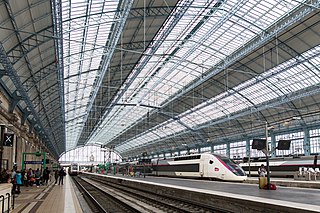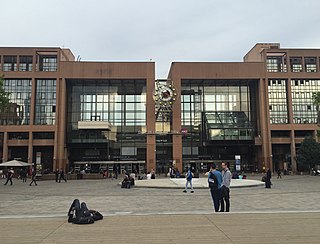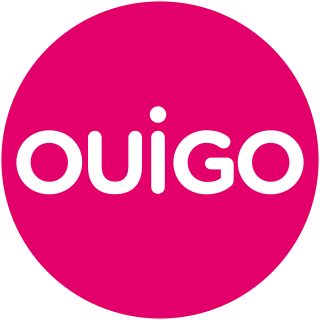
The Société nationale des chemins de fer français is France's national state-owned railway company. Founded in 1938, it operates the country's national rail traffic along with that of Monaco, including the TGV, on France's high-speed rail network. Its functions include operation of railway services for passengers and freight, as well as maintenance and signalling of rail infrastructure. The railway network consists of about 35,000 km (22,000 mi) of route, of which 2,600 km (1,600 mi) are high-speed lines and 14,500 km (9,000 mi) electrified. About 14,000 trains are operated daily.

Gare Montparnasse, officially Paris Montparnasse, is one of the seven large Paris railway termini, and is located in the 14th and 15th arrondissements.

Marne-la-Vallée – Chessy also appearing on platform displays as Marne-la-Vallée Chessy – Parcs Disneyland, is a large combined RER, and high-speed rail station in Chessy, Seine-et-Marne, France, about 30 km (19 mi) east of Paris, located on the LGV Interconnexion Est opened in 1994. The station is inside the Disneyland Paris resort, close to the entrances to the theme parks and at the entrance to Disney Village. The station opened as an extension of RER A in April 1992, in conjunction with the opening of the theme park, with The Walt Disney Company contributing €38.1 million of the €126.5 million cost. The high-speed rail part of the station opened in May 1994, two years after the RER portion of station.

Lille-Europe station is a SNCF railway station in Lille, France, on the LGV Nord high-speed railway. The station is primarily used for international Eurostar and long-distance SNCF TGV services, although some high-speed regional trains also call at the station. The station was built in 1993 to be used as a through station for trains between the UK, Belgium, and the Netherlands, as well as French TGV services, except those coming from Paris, which normally terminate at Lille-Flandres station. There is a 400-metre (1,300 ft) walking distance between the two stations, which are also connected by the Lille Metro and Lille tramway.

Bordeaux-Saint-Jean or formerly Bordeaux-Midi is the main railway station in the French city of Bordeaux. It is the southern terminus of the Paris–Bordeaux railway, and the western terminus of the Chemins de fer du Midi main line from Toulouse. The station is the main railway interchange in Aquitaine and links Bordeaux to Paris, Sète, Toulouse Matabiau and Spain.

The Gare de la Part-Dieu or Lyon-Part-Dieu is the primary railway station of Lyon, France, located in its La Part-Dieu business district. It is on the historical Paris–Marseille railway. Train services are mainly operated by the SNCF with frequent TGV high-speed and TER regional services as well as Intercités, Frecciarossa, AVE and Lyria services. Lyon's second railway station, Perrache station, is located in the south of the historical centre.

Aéroport Charles de Gaulle 2 TGV station is a major passenger railway station in Tremblay-en-France, France. It is directly beneath terminal two of Paris Charles de Gaulle Airport and is operated by the SNCF. The station was opened in November 1994 by President François Mitterrand. It connects the airport to Paris and to various other cities in France, as well as to Belgium.

Champagne-Ardenne TGV station is a railway station located in Bezannes, France that opened in 2007 along with the first phase of the LGV Est, a high-speed rail line running from Paris to Strasbourg. It is situated about five kilometres south of Reims; the station is a stop for TGV, Ouigo and TER Grand Est services.

Aix-en-Provence TGV or simply Aix TGV is a high-speed railway station on the LGV Méditerranée located on the municipal border between Aix-en-Provence and Cabriès, Bouches-du-Rhône, Southern France. Opened in 2001, the station is served by SNCF services. It serves the city of Aix-en-Provence, 15 km northeast of the station, the northernmost parts of Marseille, some 20 km to the south, as well as Marseille Provence Airport and the town of Vitrolles to the west-southwest.

The Renfe Class 100 is a high-speed train used for AVE services by the Renfe Operadora, in Spain. It was the first high-speed train put into service in Spain, in 1992.

Avignon TGV is a railway station located in Avignon, France. It was opened on 10 June 2001 and is located on the LGV Méditerranée high-speed line and Avignon-Centre–Avignon TGV railway. The train services are operated by the SNCF. The station is located 6 km south of the city centre.

Nantes station is the principal passenger railway station serving the French city of Nantes. It is a through station aligned east–west, with entrances and station facilities on both north and south sides. The two entrances are often described as Gare Nord and Gare Sud, as if they were separate stations, but they are in fact linked to each other and to all the platforms by a pedestrian subway. In 2020, after 3 years of work, a new pedestrian aerial way has been built over the railways to facilitate the passengers flow.

Douai is a railway station serving the town of Douai, Nord, France. The station opened in 1846 and is located on the Paris–Lille railway and Douai–Valenciennes railway. The train services are operated by SNCF.

Talgo Avril is a high-speed train made by Talgo. It stands for "Alta Velocidad Rueda Independiente Ligero".

Vannes is a railway station in Vannes, Brittany, France. The station was opened on 21 September 1862 is located on the Savenay–Landerneau railway. Today, the station is served by TGV, Intercités and TER (local) services operated by the SNCF.

Arras station is a railway station serving the town Arras, Pas-de-Calais department, northern France. This station, which opened in 1846, is located on the Paris–Lille railway and Arras-Dunkirk railway and accessible from LGV Nord. The train services are operated by SNCF.

Ouigo is a French low-cost service range of both conventional and high-speed trains. The literal translation of Ouigo from French to English is "yes go"; the name is also a play on words with the English homonym "we go." It is composed of two different services: Ouigo Grande Vitesse, which is a brand of SNCF operating high-speed trains; and Ouigo Vitesse Classique, a brand under which Oslo, a subsidiary of SNCF, operates conventional speed trains.

Avelia Euroduplex, more commonly known simply as Euroduplex or TGV 2N2 in France, is a high-speed double-decker train manufactured by Alstom. It is primarily operated by the French national railway company SNCF, and also in operation with the Moroccan national railway company ONCF. It is the 3rd generation of the TGV Duplex.

The Avelia Horizon, called TGV M by its main customer SNCF, is a high-speed passenger train designed and produced by Alstom. It has a broadly similar design to the TGV Duplex sets, with bi-level carriages and a push–pull configuration with a power car on either end. However, it is more energy efficient and provides lower operating costs.
Railcoop is a French rail cooperative society, headquartered in Cambes, Lot. It is one of the first private passenger service companies to be created in the aftermath of the liberalisation of rail transportation in France and the end of the monopoly on passenger transit for the national railway operator SNCF. As the rail network remains state-owned by the public agency SNCF Réseau, Railcoop operates as an independent rail operator by purchasing slots for operating its services; its schedules are regularly communicated to the national transport regulation authority.



















